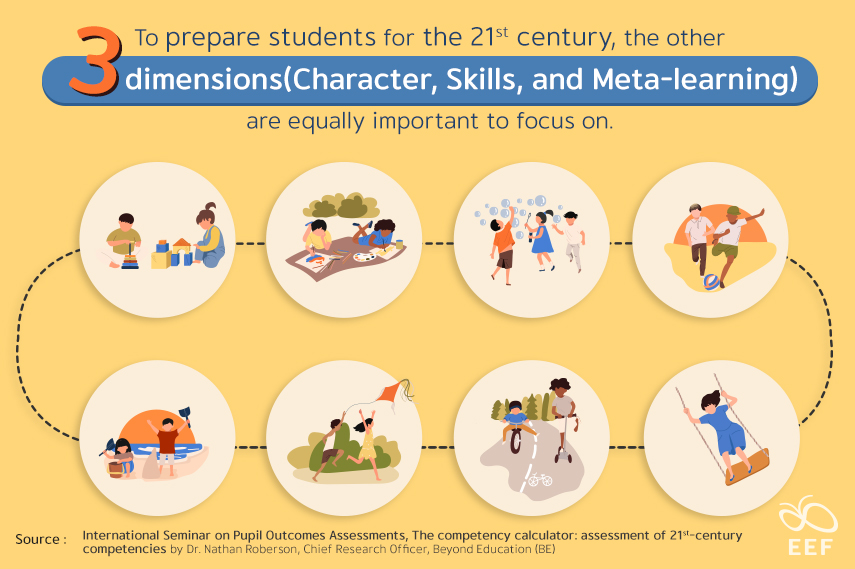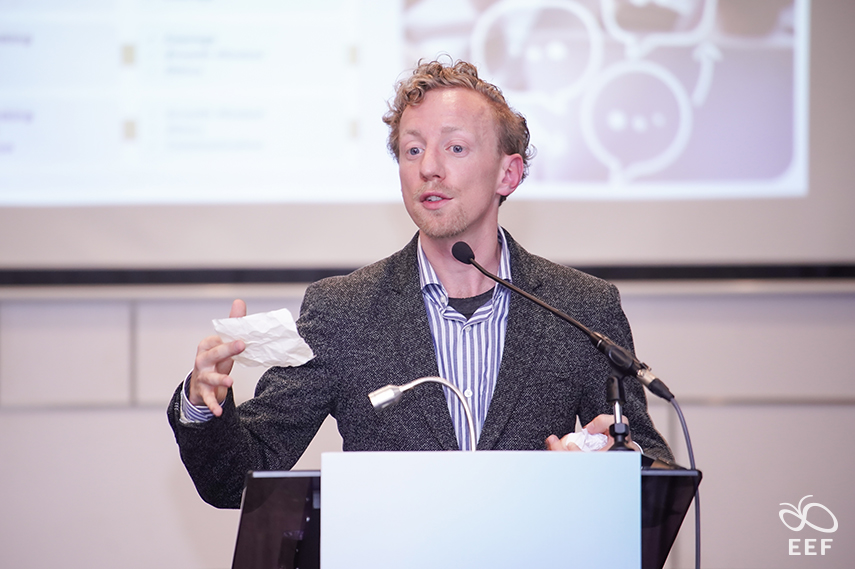
Within the educational community, there are requirements regarding significant characteristics and their practical implementation. At BE, efforts are underway to integrate programs and evaluations in the classroom to effectively utilize these attributes. The competency calculator combines 12 competencies and calculates peoples’ attributes on different elements. Beyond Education has an innovative research-based curriculum and assessment based on the Center for Curriculum Redesign (CCR)’s Four-Dimensional Education Framework. The Competency Calculator has 36 items that allow educators to verify whether and which educational programs improve 21st-century competencies and enable improvement in several areas also measured by PISA. The students taking the CCI-21 will gain an insight into their level of 21st-century competencies at a given point in time.

Based on the Center for Curriculum Redesign, four key dimensions prepare students for the 21st Century. Knowledge is the dimension mainly developed and measured in schools that teachers can carry out. However, to prepare students for the 21st century, the other three dimensions (Character, Skills, & Meta-learning) are equally important to focus on. At BE, measurement and development of these three dimensions with 12 competencies are carried out to unleash the student’s potential. The 21st-century competencies are important for academic success in terms of students’ learning outcomes within the school. Students can be more in control and more self-efficacious in the classroom. The future shows the use of AI and technology to support us in terms of our knowledge domains. The economic market in the future depends upon these types of competencies. One needs to be ready for uncertainty and ambiguity and have the necessary skills, character, and meta-learning attributes to exist in that world. BE aims to make these competencies visible to students, classroom environments, and policymakers and to be able to evaluate students’ progress in terms of understanding.

The breakdown and the list of the twelve competencies within the competency calculator include; creativity, critical thinking, communication, and collaboration, and these are the four skill competencies. Next is mindfulness, curiosity, courage, resilience, ethics, and leadership which fall under the character dimension. For meta-learning, it’s metacognition and a growth mindset. The CCI 21 is a psychometric online tool developed by BE’s research team, originally based upon the company’s experience in the curriculum redesign, where this diagnostic tool was developed. It is a self-report questionnaire that’s adapted based on students’ age. The development of these competencies changes over a student’s lifetime. The competency calculator is also age calibrated in terms of making sense of those different developmental bandwidths. With the norm referencing we use, there are four different developmental levels; beginner, intermediate, advanced, or expert level. After completing the psychometric assessment, each student would receive their developmental rating for each competency in a customized report. After completing the competency calendar, the student will see their competency, each competency, and their levels. The type of language included is in terms of a strength-based mindset, as BE would like to recognize that everyone has individual strengths and can draw on these strengths to continue their development. A definition for each student in terms of a customizable report is also provided, so they can continue to use these definitions as they go forward.
There is also a spider chart, a dynamic and visually appealing graph showing each competency level that the students can interact with a little bit more. The important thing to emphasize about the BE tool is that it is intended for the student first and foremost so that they can understand their level of 21st-century competencies. What this is intended for is to be used by the individual to understand their level of competencies within the classroom. This is also for teachers to be able to make sense of what is the distribution of students within their classroom on the 21st-century competencies so that they might be able to think about pedagogical interventions or different ways of organizing the students in their classroom so that they can make the change on these 21st-century competencies.

Dr. Nathan Roberson, Chief Research Officer, Beyond Education (BE)
For the school, BE provides an overall school description and the general score. The breakdowns of the most and least developed competencies among the students within the as a breakdown of gender by grade, by classroom, and by statistical comparisons of gender is provided. Gender groups, grade competencies, and network comparisons are considered. Elaborated results for those interested in the more technical breakdown of some of these things are also provided. The company strives to keep things simple, intelligible, and digestible within the Digest report so that teachers, classrooms, and principals can understand it. But for those who are used to working with data, BE provides a more elaborate breakdown of the results so that the analysis could go a bit further. BE works with the schools and trains them that the tool can be run within the school and connects it very explicitly to the content within their school.
BE is working on 21st-century competencies, which they manage through executive function development, creativity exercises, and behavioral management approaches that can be used in the classroom. The BE assessment tool provides a framework to make sense of the instructional strategies they already use in the classroom. It also provided them with a test to understand and confirm some of the activities they were already doing in their classroom and make possible recommendations about where they can improve their classroom environments in those senses.
An example of one type of page in the Digest Report is a list of the grades in the school, the improvable competencies by grade, and the asset competencies. What’s important about strength-based approaches is that you use your assets to support your growth in the improvable competencies. To measure creativity, you have to use these sub-competencies for each of them based on the CCR framework that is used, and then through our online tool, the students respond to the scales in terms of getting their assessment for creativity.
The timeline for growing one’s competencies is that many of them exist, and they grow and develop over a human timeline and the sense of age and maturation development. The BE assessment is limited to only twice a year. To build the assessment, the CCR framework in terms of constructing it was taken, which is the basis on which the company drew to develop the items that went into it. The developed items ultimately took a classical test theory approach in the measurement field. The company collected many items in a particular scenario and tested them in the field. Subsequently, they utilized various psychometric techniques, such as analyzing alpha inter-item correlations, to evaluate the performance of each item. Their analysis identified items that were not performing well and removed them from the scale. Likewise, a series of confirmatory factor analyses and exploratory factor analyses were conducted to understand where there were cross-loadings. In addition to the techniques, the researchers further employed exploratory factor analysis better to understand the potential cross-loadings of the remaining items. Through this process, they could identify which items were measuring which specific competencies and make the necessary adjustments to ensure that each competency was clearly defined within the scale. Within the field, the three elements that are considered are reliability, sensitivity, and validity. Age calibration is accounted for, and that’s important as there has to be an adjustment to the fact that older students are more mature than younger students, enabling educators to have a similar tool with different age groups of students in the classrooms.
 International Seminar on Pupil Outcomes Assessments, The competency calculator: assessment of 21st-century competencies by Dr. Nathan Roberson, Chief Research Officer, Beyond Education (BE)
International Seminar on Pupil Outcomes Assessments, The competency calculator: assessment of 21st-century competencies by Dr. Nathan Roberson, Chief Research Officer, Beyond Education (BE)
The BE tool is globally relevant and locally adapted to local contexts, classrooms, and individuals. The tool currently exists in English, Portuguese, and French, taking into account cultural relevance. This tool is more than an assessment., it’s also a programmatic solution that the company is working on with its team of curriculum developers. BE is attempting to determine what specific aspects of these competencies need to be targeted to achieve the desired changes in the classroom. This will enable them to develop more effective interventions and strategies for promoting the development of these competencies among students. The company also works with the local partners to understand the interventions they are implementing in their classroom context and their schools aligned to the CCR framework. The primary objective is to ensure that the assessment tools are utilized effectively and valued by educators to make a meaningful impact at the student level. Ultimately, the aim is to initiate a bottom-up transformation in which students are equipped with the necessary competencies to thrive in the 21st century.
Source:
Record of the Conference: Here
International Seminar on Pupil Outcomes Assessments, The competency calculator: assessment of 21st-century competencies by Dr. Nathan Roberson, Chief Research Officer, Beyond Education (BE)

